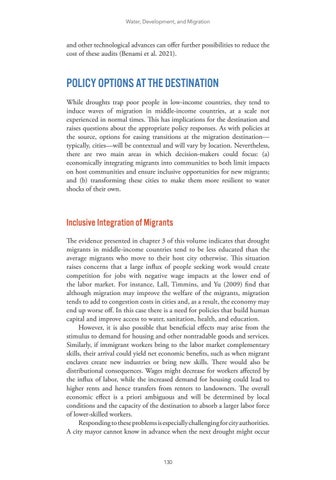Water, Development, and Migration
and other technological advances can offer further possibilities to reduce the cost of these audits (Benami et al. 2021).
POLICY OPTIONS AT THE DESTINATION While droughts trap poor people in low-income countries, they tend to induce waves of migration in middle-income countries, at a scale not experienced in normal times. This has implications for the destination and raises questions about the appropriate policy responses. As with policies at the source, options for easing transitions at the migration destination— typically, cities—will be contextual and will vary by location. Nevertheless, there are two main areas in which decision-makers could focus: (a) economically integrating migrants into communities to both limit impacts on host communities and ensure inclusive opportunities for new migrants; and (b) transforming these cities to make them more resilient to water shocks of their own.
Inclusive Integration of Migrants The evidence presented in chapter 3 of this volume indicates that drought migrants in middle-income countries tend to be less educated than the average migrants who move to their host city otherwise. This situation raises concerns that a large influx of people seeking work would create competition for jobs with negative wage impacts at the lower end of the labor market. For instance, Lall, Timmins, and Yu (2009) find that although migration may improve the welfare of the migrants, migration tends to add to congestion costs in cities and, as a result, the economy may end up worse off. In this case there is a need for policies that build human capital and improve access to water, sanitation, health, and education. However, it is also possible that beneficial effects may arise from the stimulus to demand for housing and other nontradable goods and services. Similarly, if immigrant workers bring to the labor market complementary skills, their arrival could yield net economic benefits, such as when migrant enclaves create new industries or bring new skills. There would also be distributional consequences. Wages might decrease for workers affected by the influx of labor, while the increased demand for housing could lead to higher rents and hence transfers from renters to landowners. The overall economic effect is a priori ambiguous and will be determined by local conditions and the capacity of the destination to absorb a larger labor force of lower-skilled workers. Responding to these problems is especially challenging for city authorities. A city mayor cannot know in advance when the next drought might occur
130



